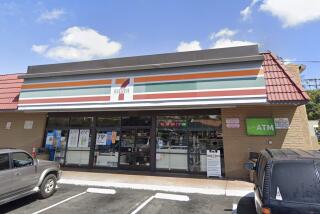Protests reflect deep divisions in Anaheim
In a city best known for Disneyland, the Angels and the Ducks, the fatal police shootings of two Latino men over the weekend have uncorked days of furious, sometimes violent protests.
The unrest has exposed long-simmering divisions in Anaheim between the glitz of Disney and professional sports and the struggles in some of the less prosperous Latino neighborhoods in Orange County’s largest city.
Of the city’s estimated 340,000 residents, 53% are Latino, and the protests have occurred in the city’s flatlands, where many of those residents live. Most City Council members hail from the more affluent Anaheim Hills neighborhood to the east. The American Civil Liberties Union recently filed suit claiming the current at-large system of electing the council leaves Latinos poorly represented. The suit said that Anaheim has had only three Latino council members in its history.
PHOTOS: Anaheim police shooting protests
The extent of the ethnic discord is hard to assess, as are accusations from some protesters that the Anaheim Police Department mistreats nonwhite residents. City leaders have asked federal and state officials to conduct independent examinations of the shootings and deny that the police harass Latino residents.
Rusty Kennedy, executive director of Orange County Human Relations, said anger over the weekend shootings reflects wider woes in Anaheim’s poorest communities, which suffer from unemployment, overcrowding and gang activity.
“It’s a hot summer, school’s out, and frustrations from the economy are certainly being felt,” Kennedy said. “There are really good families in these neighborhoods that are just struggling to survive. They have fears their child will get in between the gang members and police.”
DISCUSS: Anaheim unrest, racial divisions
The recent troubles started on Saturday afternoon, after police fatally shot an unarmed man, Manuel Angel Diaz, 25, whose nickname was Stomper. The police union alleges he was seen reaching for something in his waistband.
As Diaz lay near death on an apartment lawn, anger swept through the streets. Soon protesters were hurling bottles at police, while officers fired bean bags. A police dog broke free and attacked protesters.
A day later, police killed another man, Joel Acevedo, 21, who they say had fired at officers during a foot chase. Police released a photo of a handgun lying between his legs.
Protests erupted downtown Tuesday night, with crowds that police estimated in excess of 1,000 people. Police Chief John Welter said police declared it an unlawful assembly after it grew dangerous. He said 50 to 100 protesters continued roaming the streets, throwing rocks and bottles, and damaging more than 20 businesses, mostly breaking windows. There was also damage to City Hall and the Police Department building.
Police used pepper-spray balls and bean bags to quell the crowd, and 24 people were arrested.
“Anaheim is a strong community and a community that works together to solve its problems,” Mayor Tom Tait said at a news conference Wednesday. “I think it’s important for city officials to hear from people we serve … but violence and vandalism have no part in the conversation.”
Rosaries, baseball caps, and handwritten notes have been hung on the fence next to where Diaz was shot.
Residents remained on edge, many saying family members and friends were still in jail after the confrontation with police on Saturday evening.
Yolanda Delgado, 68, a longtime Anaheim resident, saw a group of young looters smashing the windows of a T-shirt store Tuesday night and began yelling at them. At one point, she scuffled with a young woman who she said was trying to steal shoelaces. The young woman punched her and bloodied her lip.
Delgado said she was incensed that rioters were destroying the property of innocent people. “I was ashamed of them — the stupidity, the ignorance,” she said. “This is what the Latino community is trying to [alleviate]. They’re tired of being known just as thieves or gardeners or housekeepers.”
Some see a growing gulf between the city’s image as a tourist utopia and the unhappiness of some residents.
Gustavo Arellano, who grew up in Anaheim and now edits the OC Weekly alternative newspaper, said the city has poured millions of dollars into its resort district to the exclusion of the poor neighborhoods that need it.
He said he has sensed more fear among Anaheim residents in recent years than he can remember, as a result of crime and “gang members hanging out with impunity.”
“What you have is all these young men who graduated from high school, and there are no job opportunities, and they’re drawn into the criminal life,” Arellano said. “While this is happening, the city leaders have done next to nothing to tackle this issue.”
Caught in the middle, he said, are decent people who don’t like crime but feel alienated from police.
He spoke of “the whole facade of Orange County,” adding: “People think it’s the beach and the sun and Republicans. And Anaheim is a microcosm” of that misperception.
There is also a history of tension. In 1978, a riot at Little People’s Park involving Anaheim police and a group of Latinos led to accusations of police brutality and a series of reforms.
City officials said they believe most of Tuesday’s protesters were not from Anaheim, and Tait said they had taken “advantage of this evening of dialogue [during a City Council meeting] to try to create chaos in our downtown neighborhoods.”
Diaz’s mother, Genevieve Huizar, has filed a civil rights and wrongful-death lawsuit alleging police shot her son from behind, and when he fell to his knees, shot him in the back of the head.
Huizar called on Anaheim’s Latino residents to refrain from violence. “This is wrong and needs to stop on both sides,” she said.
She described her son as a “good-hearted person” who loved his 14 nieces and nephews.
Dana Douglas, the Diaz family attorney, said Diaz lived with his mother in Santa Ana and had just gotten off probation for a handgun conviction.
She said the shooting is a civil rights issue because it reflects a pattern of abuse by Anaheim police. “Police don’t roust white kids in affluent neighborhoods who are just having a conversation,” Douglas said. “And those kids have no reason to fear police. But young men with brown skin in poor neighborhoods do.”
Tuesday’s unrest made national headlines. But it remains unclear how much it pierced the tourist bubble in and around Disneyland.
At the Super 8 hotel near the amusement park, desk clerk Ana Saldana said she has had only one inquiry from a worried family about the riots over the last few days.
“Most of the guests are not even aware of it,” she said. “Because when they come here, I don’t think they watch the news. They just want to go to Disneyland.”
christopher.goffard@latimes.com
Times staff writers Ruben Vives and Christine Mai-Duc contributed to this report.
More to Read
Sign up for Essential California
The most important California stories and recommendations in your inbox every morning.
You may occasionally receive promotional content from the Los Angeles Times.












